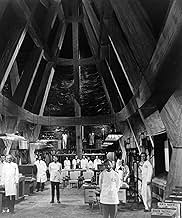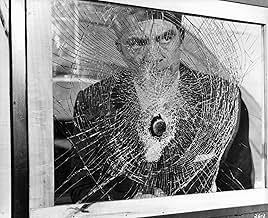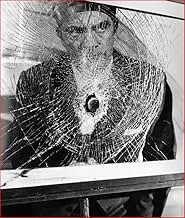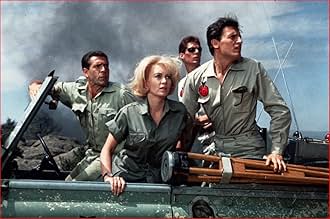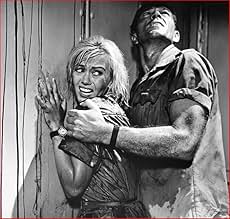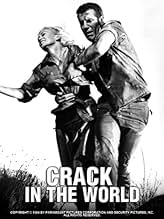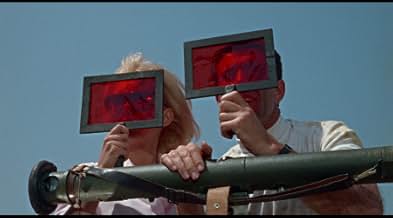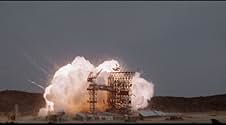Des scientifiques percent la croûte terrestre dans l'espoir d'utiliser le magna comme source d'énergie. Un obstacle les forcent à utiliser une bombe atomique. Mais, cette action remet en que... Tout lireDes scientifiques percent la croûte terrestre dans l'espoir d'utiliser le magna comme source d'énergie. Un obstacle les forcent à utiliser une bombe atomique. Mais, cette action remet en question l'intégrité de la Terre.Des scientifiques percent la croûte terrestre dans l'espoir d'utiliser le magna comme source d'énergie. Un obstacle les forcent à utiliser une bombe atomique. Mais, cette action remet en question l'intégrité de la Terre.
- Réalisation
- Scénario
- Casting principal
- Member of the Commission
- (non crédité)
Avis à la une
GORGO director Eugene Lourie supervised the special effects, and there are several standout sequences of miniatures photography, along with the usual requisite stock footage, some good and some NSG. There's also a well-handled set piece of thermal-suited scientists descending into a volcanic caldera in order to place an A-bomb that generates some good suspense. (We'll overlook the subsequent post-blast scene where there is disconcertingly no shock wave.) I saw this on a double bill (it was the 2nd feature) with a Japanese giant monster flick back in the 60's; can't remember the monster (maybe Ghidrah?) but this is the picture that sticks in my mind. The denouement is audacious and thought- provoking.
To us in 2011, its special effects might be laughable, and yes we know that you wouldn't fire a missile down a hole to punch into magma with a nuclear warhead. But it is a delightfully unique story of ingenuity that contains a major element that *has* come to pass, albeit not as the writers foresaw - the development of geothermal energy. It also showcases a time 55 years ago when no one had any idea what the inside of the Earth was like! The movie was based on best-guess geology, and what they developed made it fun. Further, it notes the potential dangers of messing with Mother Earth unless you're absolutely sure of what you're doing.
Many pieces of technology and social graces speak well to illustrate a period in history that many of us were either too young to remember, or not even born yet.
As I said, this is not Industrial Light and Magic, but the special effects are great for the period. I have and always will be a fan of using detailed miniatures.
I gave this movie a very high rating because it's just a good flick to sit down and watch. The story is fun and interesting, but not heavy. The science is wrong but at least they tried, and you have to smile at that. Astonishingly, the casting and acting is decent as well.
Be sure to find some time for this movie, and don't be afraid, this is *not* a 1956 version of "The Core." They are entirely different movies of both type and quality.
The pace of action and buildup to the spectacular climax is first-rate. I found myself just waiting for the next disaster to make itself manifest, be it an earthquake, volcano, tsunami, or all three. The underlying message is still sound: mankind should use caution in tinkering with the forces of nature. A time-worn premise, to be sure, but no less valid today. We as a species are young and have much to learn, by being aware of the hidden forces of nature and the unintended consequences of good-intentioned tinkering.
The cast is quite good. Sci-fi stalwart Dana Andrews is the featured player, of course, but the other actors do some good work. For it's time, the special effects are well-done. Like any well-paced disaster film, as the action races to a climax, we find ourselves pulling for the "good" guys against, hey, wait a minute, there are no "bad guys", just the unleashed forces of nature, knowing no good or evil, just following their natural course. It's a fun twist and makes you think.
Overall, it's hard not to recommend "Crack in the World" for a fun couple of hours' escapism and entertainment. Just suspend the disbelief a bit and go along for the ride.
Copious stock footage mixes with pretty impressive special effects, designed by Eugene Lourie, himself the director of the classic dinosaur flick "The Beast from 20,000 Fathoms". Some viewers may be able to poke a lot of holes in the "science fact" aspect to the screenplay, but this shouldn't get in the way of enjoying what is a reasonably entertaining forerunner to the "disaster film cycle" of the 1970s. It's rather slow to get started, and does devote a fair amount of the running time to the love triangle. Ultimately, it delivers the goods if you stick with it. One thing about it that people should appreciate is the fact that it doesn't necessarily guarantee the viewer a happy ending. It keeps you hanging until its final frame. Among its other assets are the art direction (by Lourie), cinematography (by Manuel Berenguer), and music (by Johnny Douglas).
Andrews gives a typically solid performance in the lead, but most everybody here is fine. That includes the gorgeous Janette Scott as the female scientist caught between Ted and Stephen. Alexander Knox rounds out the quartet of top billed performers in the role of the pragmatic Sir Charles Eggerston.
This does offer a fair amount of fun if you're looking to discover sci-fi and disaster pictures from decades past.
Seven out of 10.
What needs to remembered here is that this came BEFORE the disaster movies of the 1970s (Earthquake, The Towering Inferno, The Swarm, etc) and you have to wonder just how much of this film was copied by Irwin Allen and others. The music of the film has what now seems like rather routine "disaster music", but back then, the opening score would have been like nothing nobody had heard before. Think about it.
Crack In The World is a wonderfully scripted, acted, filmed, scored, epic that deserves more attention than it gets. Maybe the average science in the plot is the reason it does not get talked about a lot these days?
Le saviez-vous
- AnecdotesEugène Lourié had two models of the gantry built. The second was made of balsa wood for the explosion scene. This insured complete destruction of the gantry while avoiding the danger of the set being sprayed by shrapnel.
- GaffesMost of the vehicles in the movie have their steering wheels on the left; however, the action is supposed to take place in Tanganyika, a former British colony which drives on the left and auto steering wheels are on the right of the car.
- Citations
[Rampion is revived after being pulled unconscious from a volcanic vent]
Simpson: How do you feel?
Dr. Ted Rampion: Medium rare.
Meilleurs choix
- How long is Crack in the World?Alimenté par Alexa
Détails
- Date de sortie
- Pays d’origine
- Langue
- Aussi connu sous le nom de
- Quand la Terre s'entrouvrira
- Lieux de tournage
- Madrid, Espagne(UN meeting hall)
- Société de production
- Voir plus de crédits d'entreprise sur IMDbPro
Box-office
- Budget
- 873 000 $US (estimé)
- Durée1 heure 36 minutes
- Rapport de forme
- 1.85 : 1
Contribuer à cette page



